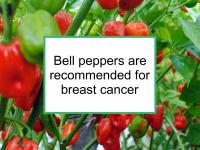Bell peppers (Capsicum annuum var. grossum), which are the predominant type of sweet peppers consumed in the U.S., come in a variety of colors, most commonly, green, red and yellow. Bell peppers are excellent dietary sources of vitamin C and vitamin A and also contain folate. Hot peppers are covered in another webpage.
Bell peppers have been shown to have anti-inflammatory, antioxidant, radioprotective, and antimutagenic properties and may help lower cholesterol levels.
Bell peppers contain several micronutrients with demonstrated cancer fighting properties, including apigenin, lupeol, quercetin, and capsiate, as well as carotenoids such as beta-carotene, beta-cryptoxanthin, capsanthin, and lycopene. Bell pepper consumption has been found to be associated with lower risk of liver and prostate cancer, as well as brain gliomas in women.
Breast cancer-related effects of eating bell peppers
Several Korean studies have found an association between bell pepper consumption and lower incidence of breast cancer. On the other hand, green pepper consumption was not found to have a significant inverse association with breast cancer in a Nurses Health Study II study.
Apigenin
Apigenin, a flavone component of bell peppers, has been shown to exhibit potent growth-inhibitory effects in HER2 overexpressing (HER2+) breast cancer cells. Apigenin has also been shown to inhibit the growth of patient-derived triple negative (ER-/PR-/HER2-) organoids and sensitize triple negative cells to doxorubicin chemotherapy. In addition, apigenin has been shown to lessen doxorubicin-induced kidney damage without reducing its cytotoxic effects against tumor cells in a mouse model of breast cancer.
Quercetin
Bell pepper flavonol quercetin has been shown to increase the effectiveness of both doxorubicin and paclitaxel chemotherapy in multidrug resistant ER+/PR+ breast cancer cells, in part by eliminating cancer stem cells. In addition, quercetin has been reported to increase the sensitivity of ER+/PR+ cells to 5-fluorouracil (5-FU), thereby increasing its treatment effects. Quercetin has also been found to inhibit the migration and adhesion of triple negative (ER-/PR-/HER2-) breast cancer cells and to significantly inhibit tumor progression in a mouse model of triple negative breast cancer. Finally, quercetin also acts as an iron chelator, which can help reduce iron's breast cancer-promoting effects in some women.
Carotenoids
Bell peppers, especially red bell peppers, are a very good source of carotenoids. Dietary beta-carotene has been found to be inversely associated with the risk of ER+/PR+ breast cancer. Dietary carotenoids such as beta-carotene have been found to inhibit the cancer-promoting effects of both estradiol and genistein (the phytoestrogen found in soy), thereby reducing their potentially harmful effects in hormone-dependent breast cancer.
Capsanthin (a red carotenoid found in red bell peppers) has been reported to reduce the viability of ER+/PR+ breast cancer cells and inhibit the proliferation of triple negative breast cancer cells. Capsanthin has also been demonstrated to reduce the number and growth of mammary tumors in a mouse model of triple negative breast cancer.
Several studies of early stage breast cancer survivors have found that higher levels of cartenoids in the blood are associated with both lower risk of break cancer recurrence and lower risk of a new primary breast tumor. Plasma levels of retinol (a form of vitamin A that is a by-product of beta-carotene in the body) have also been found to be positively associated with breast cancer survival in postmenopausal women.
Additional comments
Green bell peppers have a higher phenolic content than red bell peppers, whereas red bell peppers (which are the same fruit, but further along in ripening) have higher vitamin C and carotenoid contents. The pimento stuffing found in some olives and paprika are both typically prepared from sweet peppers such as red bell peppers.
Non-organic bell peppers must be washed very thoroughly to remove pesticide residue as much as possible.
Sources of information provided in this webpage
The information above, which is updated continually as new research becomes available, has been developed based solely on the results of academic studies. Clicking on any of the underlined terms will take you to its tag or webpage, which contain more extensive information.
Below are links to 20 recent studies concerning this food and its components. For a list of studies that includes older research, please click on bell peppers.
